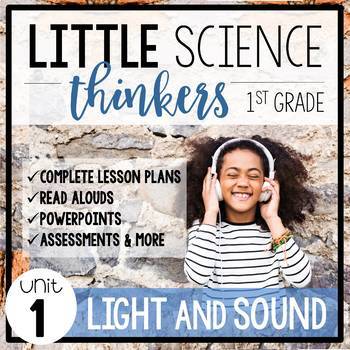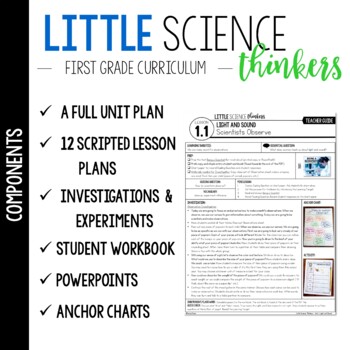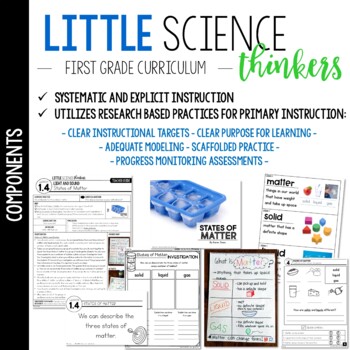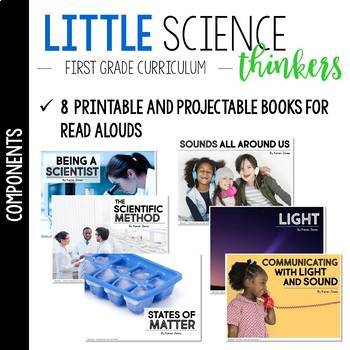Little 1st Grade SCIENCE Thinkers {UNIT 1: Light and Sound}
- Zip
What educators are saying
Also included in
- Little SCIENCE Thinkers is a complete curriculum specifically for First Grade. It's everything you need to introduce, teach, practice, and assess your students. It is cross-referenced with and written using the main topics of state First Grade Science Standards and many NGSS (Click here for the TEPrice $79.95Original Price $89.75Save $9.80
Description
Little 1st Grade SCIENCE Thinkers is a complete science curriculum specifically for first grade. It's everything you need to introduce, teach, practice, and assess your students. It incorporates both the NGSS standards as well as many state standards for 1st grade science. This curriculum was completely researched, designed, and created by Karen Jones.
UNIT 1: LIGHT AND SOUND teaches your little learners all becoming a scientist, matter, light, and sound. It's a perfect introduction to science in the beginning of the school year and includes many hands-on science experiences for your class. It includes lessons on these topics:
Making observations
Science Tools and Safety
The Scientific Method
Matter
Properties of Matter
Sound and Vibrations
Light
Communicating with Light and Sound
--------------------WHAT'S INCLUDED?---------------------
COMPONENTS OF THE UNIT:
-A complete Teacher Guide
-8 printable/projectable Books for Read-Alouds
-Step-by-step, Scripted Lesson Plans (Twelve, 30-minute lesson plans in all)
-Essential Question and Learning Target Posters
-Anchor Charts
-Hands-on Investigations and an Experiment
-Science Stations
-Whole group Activities
-Vocabulary Cards
-Student Workbook
-Quick Checks
-Assessment and Rubric for scoring
-Parent Letter
-A COMPLETE unit PowerPoint to guide your teaching during each and every lesson (all books, targets, activity and workbook pages are included in the PowerPoint to help you save paper)
**PLEASE NOTE** This unit contains many hands-on investigations. In order to teach the lessons you will need various typical classroom supplies as well as the following materials: mini-flashlights, marbles, small containers of bubbles, a submersible thermometer, measuring cups and spoons, and a pan balance.
OUTLINE OF UNIT 1:
Lesson 1: SCIENTISTS OBSERVE
Lesson 2: SCIENCE TOOLS AND SAFETY
Lesson 3: THE SCIENTIFIC METHOD
Lesson 4: STATES OF MATTER
Lesson 5: PROPERTIES OF MATTER
Lesson 6: SOUND AND VIBRATIONS
Lesson 7: LIGHT
Lesson 8: USING LIGHT AND SOUND TO COMMUNICATE
Lesson 9: COMMUNICATING USING LIGHT OR SOUND INVESTIGATION
Lesson 10: HANDS-ON SCIENCE STATIONS (2 DAYS)
Lesson 11: REVIEW
Lesson 12: UNIT ASSESSMENT
*Please download the preview to see all that is included, including samples of everything!*
-------------------------WANT MORE?----------------------------
OTHER LITTLE 1ST GRADE SCIENCE THINKERS UNITS:
UNIT 1: Light and Sound
UNIT 4: Survival of Living Things
Please note: A full curriculum bundle is also available.
----------------------BUYING FOR A TEAM?--------------------------
LICENSING TERMS: This purchase includes a license for one teacher only for personal use in their classroom. Licenses are non-transferable, meaning they can not be passed from one teacher to another. No part of this resource is to be shared with colleagues or used by an entire grade level, school, or district without purchasing the proper number of licenses. If you are a coach, principal, or district interested in transferable licenses to accommodate yearly staff changes, please contact me for a quote at karen@mrsjonessclass.com .
--------------------------RELATED UNITS--------------------------------
KINDERGARTEN Little Science Thinkers Curriculum
FIRST GRADE Little Social Studies Thinkers Curriculum
------------------------------------------------------------------------------------






